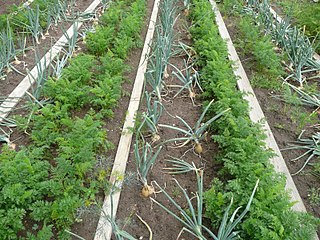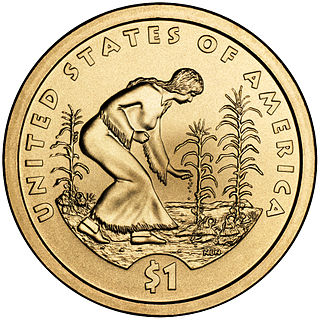 W
WPermaculture is, amongst others, an approach to land management that adopts arrangements observed in flourishing natural ecosystems. It includes a set of design principles derived using whole systems thinking. It uses these principles in fields such as regenerative agriculture, rewilding, and community resilience. Permaculture originally came from "permanent agriculture", but was later adjusted to mean "permanent culture", incorporating social aspects as inspired by Masanobu Fukuoka's natural farming. The term was coined by Bill Mollison and David Holmgren in 1978, who formulated the concept in opposition to Western industrialized methods and in congruence with Indigenous or traditional knowledge.
 W
WA permaculture project is a deployment of permaculture practices on an ongoing basis.
 W
WAn arborloo is a simple type of composting toilet in which feces are collected in a shallow pit and a fruit tree is later planted in the fertile soil of the full pit. Arborloos have: a pit like a pit latrine but less deep; a concrete, ferrocement or other strong floor; a superstructure to provide privacy; and possibly a ring beam to protect the pit from collapsing. The pit should remain well above the water table in the soil, so as to not contaminate groundwater.
 W
WCompanion planting in gardening and agriculture is the planting of different crops in proximity for any of a number of different reasons, including pest control, pollination, providing habitat for beneficial insects, maximizing use of space, and to otherwise increase crop productivity. Companion planting is a form of polyculture.
 W
WCompost is a mixture of ingredients used to fertilize and improve the soil. It is commonly prepared by decomposing plant and food waste and recycling organic materials. The resulting mixture is rich in plant nutrients and beneficial organisms, such as worms and fungal mycelium. Compost improves soil fertility in gardens, landscaping, horticulture, urban agriculture, and organic farming. The benefits of compost include providing nutrients to crops as fertilizer, acting as a soil conditioner, increasing the humus or humic acid contents of the soil, and introducing beneficial colonies of microbes that help to suppress pathogens in the soil. It also reduces expenses on commercial chemical fertilizers for recreational gardeners and commercial farmers alike. Compost can also be used for land and stream reclamation, wetland construction, and landfill cover.
 W
WA composting toilet is a type of dry toilet that treats human waste by a biological process called composting. This process leads to the decomposition of organic matter and turns human waste into compost-like material. Composting is carried out by microorganisms under controlled aerobic conditions. Most composting toilets use no water for flushing and are therefore called "dry toilets".
 W
WEcosynthesis is the use of introduced species to fill niches in a disrupted environment, with the aim of increasing the speed of ecological restoration. This decreases the amount of physical damage done in a disrupted landscape. An example is using willow in a stream corridor for sediment and phosphorus capture. It aims to aid ecological restoration, the practice of renewing and restoring degraded, damaged, or destroyed ecosystems and habitats in the environment by active human intervention and action. Humans use ecosynthesis to make environments more suitable for life, through restoration ecology
 W
WFoodscaping is a modern term for the practice of integrating edible plants into ornamental landscapes. It is also referred to as edible landscaping and has been described as a crossbreed between landscaping and farming. As an ideology, foodscaping aims to show that edible plants are not only consumable, but can also be appreciated for their aesthetic qualities. Foodscaping spaces are seen as multi-functional landscapes which are visually attractive and also provide edible returns.
 W
WA grassed waterway is a 2-metre (6.6 ft) to 48-metre-wide native grassland strip of green belt. It is generally installed in the thalweg, the deepest continuous line along a valley or watercourse, of a cultivated dry valley in order to control erosion. A study carried out on a grassed waterway during 8 years in Bavaria showed that it can lead to several other types of positive impacts, e.g. on biodiversity.
 W
WIntercropping is a multiple cropping practice that involves growing two or more crops in proximity. In other words, intercropping is the cultivation of two or more crops simultaneously on the same field. The most common goal of intercropping is to produce a greater yield on a given piece of land by making use of resources or ecological processes that would otherwise not be utilized by a single crop.
 W
WKeyline design is a landscaping technique of maximizing the beneficial use of the water resources of a tract of land. The "keyline" denominates a specific topographic feature related to the natural flow of water on the tract. Keyline design is a system of principles and techniques of developing rural and urban landscapes to optimize use of their water resources.
 W
WMarine Permaculture is a form of mariculture that reflects the principles of permaculture by recreating seaweed forest habitat and other ecosystems in nearshore and offshore ocean environments. Doing so enables a sustainable long-term harvest of seaweeds and seafood, while regenerating life in the ocean.
 W
WA mulch is a layer of material applied to the surface of soil. Reasons for applying mulch include conservation of soil moisture, improving fertility and health of the soil, reducing weed growth and enhancing the visual appeal of the area.
 W
WMycoforestry is an ecological forest management system implemented to enhance forest ecosystems and plant communities through the introduction of mycorrhizal and saprotrophic fungi. Mycoforestry is considered a type of permaculture and can be implemented as a beneficial component of an agroforestry system. Mycoforestry can enhance the yields of tree crops and produce edible mushrooms, an economically valuable product. By integrating plant-fungal associations into a forestry management system, native forests can be preserved, wood waste can be recycled back into the ecosystem, planted restoration sites are enhanced, and the sustainability of forest ecosystems are improved. Mycoforestry is an alternative to the practice of clearcutting, which removes dead wood from forests, thereby diminishing nutrient availability and reducing soil depth.
 W
WPolyculture is a form of agriculture in which more than one species is grown at the same time and place in imitation of the diversity of natural ecosystems. Polyculture is the opposite of monoculture, in which only members of one plant or animal species are cultivated together. Polyculture has traditionally been the most prevalent form of agriculture in most parts of the world and is growing in popularity today due to its environmental and health benefits. There are many types of polyculture including annual polycultures such as intercropping and cover cropping, permaculture, and integrated aquaculture. Polyculture is advantageous because of its ability to control pests, weeds, and disease without major chemical inputs. As such, polyculture is considered a sustainable form of agriculture. However, issues with crop yield and biological competition have caused many modern major industrial food producers to continue to rely on monoculture instead.
 W
WRaised-bed gardening is a form of gardening in which the soil is enclosed in three-to-four-foot-wide (1.0–1.2 m) containment units ("beds"), which are usually made of wood, rock, or concrete and which can be of any length or shape. The soil is raised above the surrounding soil and may be enriched with compost.
 W
WRegenerative agriculture is a conservation and rehabilitation approach to food and farming systems. It focuses on topsoil regeneration, increasing biodiversity, improving the water cycle, enhancing ecosystem services, supporting biosequestration, increasing resilience to climate change, and strengthening the health and vitality of farm soil.
 W
WA rocket mass heater (RMH), also known as rocket stove mass heater, is a form of slow-release radiant heating system, designed to primarily heat people and secondarily to warm areas in line of sight around it. Variations of RMH can also be extended for the functions of cooking, heating water, and producing warm air for distribution.
 W
WThe Three Sisters are the three main agricultural crops of various Indigenous peoples of North America: winter squash, maize (corn), and climbing beans. Originating in Mesoamerica, these three crops were carried northward, up the river valleys over generations, far afield to the Mandan and Iroquois who, among others, used these Three Sisters for food and trade.
 W
WVillage Homes is a planned community in Davis, Yolo County, California. It is designed to be ecologically sustainable by harnessing the energies and natural resources that exist in the landscape, especially stormwater and solar energy.